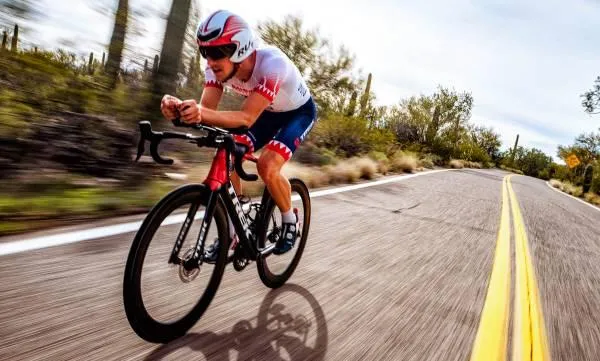
Fitting Aerobars to a Road Bike
If you’re a triathlete using a road bike, adding aerobars is one of the highest-return changes you can make. Over 13 years as a bike fitter working with road cyclists and triathletes, I’ve seen riders from beginners to elites pick up meaningful time savings, improved comfort over long distances, and a more efficient range of riding positions simply by fitting and learning to use aerobars properly.
Why aerobars matter: speed and efficiency
Aerodynamics is king on the bike. At typical triathlon speeds (25–45 kph), air resistance accounts for the bulk of the power you’re producing. Aerobars let you reduce frontal area and present a narrower, more streamlined profile to the wind, which reduces drag and therefore the power required to hold the same speed — or allows you to go faster for the same power.
Real-world impact
• Many triathletes move from a ‘hoods/drops’ road position to a tucked aero position and find they need 20–40 fewer watts to hold the same speed. The exact number depends on body size, flexibility, and how well the aero position is tuned.
• On a 40 km time trial/triathlon bike leg, that reduction in drag often corresponds to minutes saved — not seconds. For example, a well-executed aero tuck can easily reduce your time by as much as 4-5 minutes over 40 km compared with a relaxed, upright position, and more for larger riders or poorly positioned setups.
All of these are approximate; the net gain depends on you and your power output. The important point is this: shaving watts through a better aerodynamic position is one of the most efficient ways to improve race performance.
Range of positions: what you gain by combining aerobars with road bars
One of the strongest arguments for aerobars on a road bike (versus a dedicated time-trial bike) is versatility. A road bike with aerobars gives you an extended toolkit of positions to handle every part of a triathlon course.
• Hoods
• Best for: control, climbing, rolling terrain, quick braking or responsiveness in transitions.
• Benefit: instant access to brakes and shifting, good for technical sections and climbs where handling matters.
• Drops
• Best for: aggressive descents and sprinting from the road position.
• Benefit: lower center of gravity and improved handling when you need to be reactive.
• Tops
• Best for: recovery, easy spins, and short bursts of breathing room.
• Benefit: the most relaxed position for short respites between efforts.
• Aerobar tuck (elbow pads, hands on extensions)
• Best for: long, sustained power efforts on flats and gentle rolling terrain; the ‘time-trial’ posture.
• Benefit: maximum aerodynamic advantage, stable platform to hold steady power for extended periods.
Using all these positions intelligently across a race — e.g., drops for a fast technical descent, aerobars for long flat power sections, hoods for climbs and transitions — gives you the best of both worlds: speed without losing the handling and safety of a road bike.
Comfort, power and physiology
A good aero position isn’t just about being small; it’s about being sustainable. If your shoulders, neck or hips are cramping after 10 minutes in the aero tuck, the aerodynamic benefits are wasted because your power and efficiency will fall.
Key fit principles I use with triathletes:
• Slightly more forward saddle position to open the hip angle and preserve power in a more tucked posture.
• Pad width that matches shoulder width — too narrow or wide will create torque and discomfort.
• Pad height and extension length tuned so the neck and shoulders are comfortable and the lumbar curve is supported.
When those elements are optimized, many athletes actually find they can produce the same or slightly higher normalized power in the aero position because they’re more stable and less fatigued by wind and buffeting.
Safety and handling: practice makes permanent
Aerobars change how your bike steers. They reduce front-wheel loading and can make turning feel different — especially at low speeds. That’s why practice is essential:
• Train in the aero position frequently so you become confident braking, cornering and controlling the bike while tucked.
• Practice mounting and dismounting your bars smoothly so transitions are consistent.
• In group rides or draft-legal races be aware: aerobars can be restricted in some events for safety reasons. Always check race rules.
Closing thoughts
Aerobars on a road bike are a powerful tool for triathletes: they offer genuine speed gains through reduced aerodynamic drag, expand your repertoire of positions for different parts of a race, and — when properly fitted and practiced — can improve comfort and sustained power. The single most important step is a proper fit and some focused practice time so the aero position becomes comfortable and repeatable.
If you’re curious about how much an aero setup could help you specifically, I’d be happy to help. Drop me a message with your typical race distance, current bike, and any fitting issues you have and we’ll go from there.
Happy riding and racing!
Visit our website: www.custombikefit.com
Submit a bike fit enquiry: CLICK HERE
Call Michael: 0400 510 515

